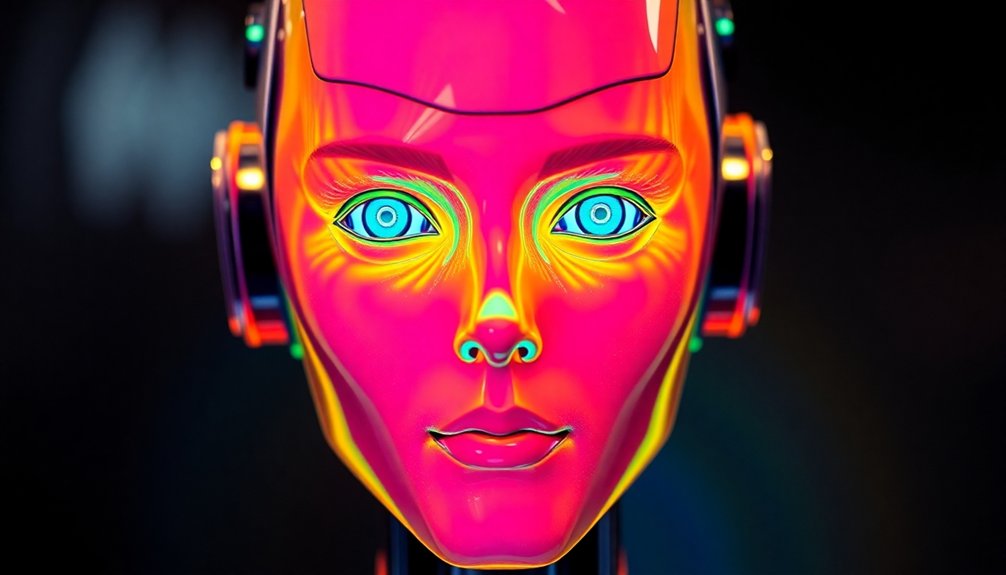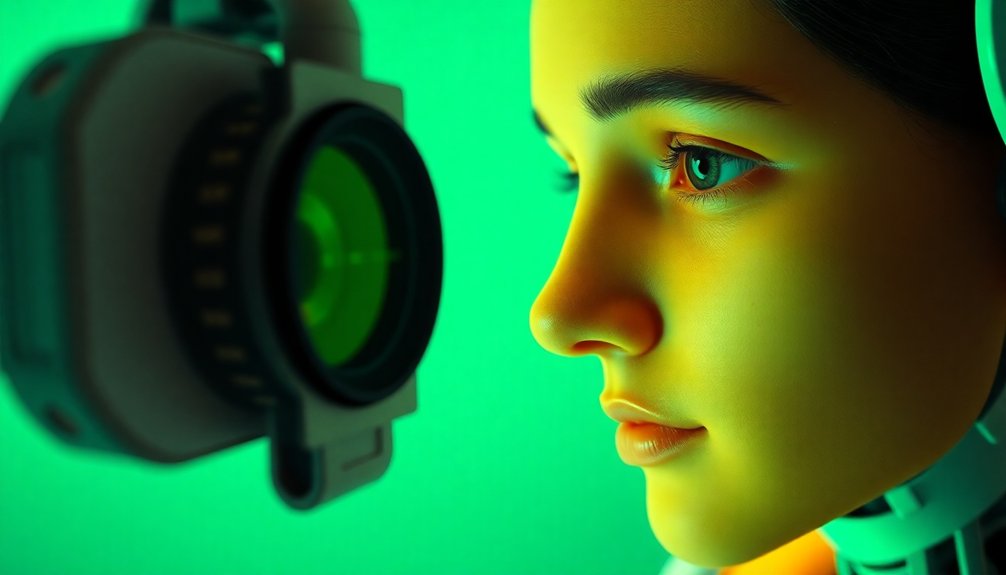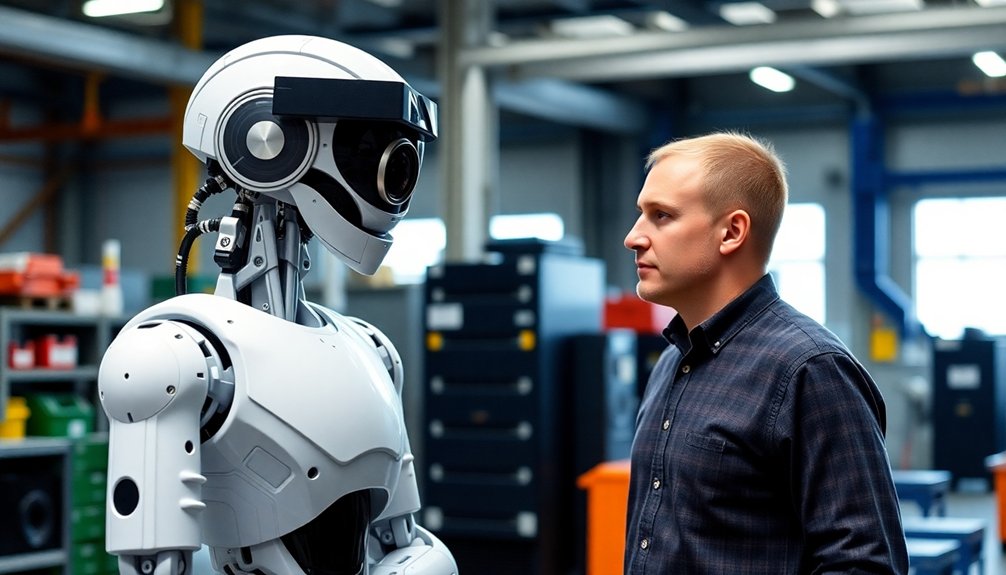Table of Contents
Robots don’t just see you—they decode you like a living algorithm. Their multi-spectral cameras capture way more than your surface: emotional micro-expressions, body language shifts, thermal signature changes. They’re tracking muscle movements, predicting reactions, and processing your entire human landscape in milliseconds. Depth sensors map your spatial existence while AI interprets every subtle signal. Think you’re just standing there? Think again. Curious about how deep this robotic rabbit hole goes?
The Digital Eye: Camera Technology in Robotic Vision

Imagine robots seeing the world not through human eyes, but through a digital lens that captures reality with precision machines could only dream of decades ago.
We’re talking about camera tech that transforms robots from blind mechanical limbs into seeing, sensing creatures. Multi-spectral imaging technologies now enable robots to capture depth, color, and contextual information beyond human visual limitations.
Robotic vision evolves: cameras transforming mechanical limbs into intelligent, context-aware sensing machines.
High-speed cameras now grab 360-degree views faster than you can blink, parsing visual data with superhuman speed.
Think six RGB cameras creating a panoramic world map, or depth sensors that read environments like a GPS on steroids. Nikon’s robot vision system enables ultra-precise robotic hand manipulation with cameras that process images at 250 frames per second. These aren’t sci-fi fantasies—they’re today’s robotic vision systems. Industrial vision systems like those from COGNEX and KEYENCE are revolutionizing how robots perceive and interact with their surroundings.
From Fourier’s multi-camera setups to Nikon’s lightning-fast sensing, we’re watching machines learn to see not just images, but understand context, movement, and potential interactions.
Who knew robots could be such visual overachievers?
Decoding Facial Landscapes: Recognition and Tracking Mechanisms
While cameras might capture images, genuinely understanding human faces requires something far more sophisticated than point-and-shoot technology. Our robotic systems dive deep into facial landscapes, transforming raw visual data into intelligent recognition: Sensor fusion techniques enable robots to integrate multiple perceptual inputs, creating a more comprehensive understanding of human facial dynamics.
- We map key facial landmarks like precise digital cartographers, converting human expressions into coordinate systems robots can comprehend.
- Cutting-edge AI algorithms analyze muscle movements, translating subtle shifts into emotional interpretations faster than most humans.
- Continuous tracking mechanisms allow robots to lock onto faces, following human interactions with predatory precision.
The Viola Jones Algorithm, a fundamental technique in face detection, enables robotic systems to rapidly identify and isolate human faces within complex visual environments. These aren’t just mechanical observations—they’re computational dissections of human communication. Sensors integrated into robotic heads provide multi-dimensional perception of environmental stimuli, enabling more nuanced and responsive interactions. By breaking down facial movements into quantifiable data points, we’re teaching machines to see beyond pixels, translating the nuanced language of human emotion into something our digital brains can understand and respond to with remarkable accuracy.
Emotional Intelligence: How Robots Read Human Expressions

We’ve got a front-row seat to the wild world of robots learning to read our emotional landscapes, where cutting-edge face detection techniques transform cold circuits into empathetic machines. Robotic facial motors now enable humanoid systems to generate more nuanced and coordinated emotional expressions, expanding their ability to communicate complex feelings through precise muscle movements.
Emotion recognition tech now lets robots decode our most subtle expressions faster than your ex could read your passive-aggressive text messages, tracking micro-expressions and emotional nuances with algorithmic precision. Neuromorphic computing allows robots to develop increasingly sophisticated emotional mimicry for more personalized interactions. The emotion detection system in Tiago++ uses advanced algorithms trained on the FER2013 dataset to categorize human emotions into seven distinct groups, enhancing robotic understanding of human emotional complexity.
Our adaptive interaction strategies mean these mechanical minds aren’t just scanning faces—they’re building a real-time emotional intelligence that could revolutionize how humans and robots communicate, turning what once seemed like sci-fi fantasy into today’s technological reality.
Face Detection Techniques
The world of humanoid robotics hinges on a robot’s ability to understand human facial expressions—and that’s where face detection techniques become our technological crystal ball. Multimodal emotional intelligence helps robots decode the nuanced emotional signals humans unconsciously emit.
We’ve developed sophisticated methods to help robots “see” humans, transforming cold machine perception into something almost intuitive. Advanced multimodal emotion detection architectures are expanding robots’ capability to interpret complex human emotional landscapes beyond simple facial recognition.
Our face detection arsenal includes:
- CNN algorithms that learn facial patterns like digital detectives
- Haar cascades that scan images faster than you can blink
- Multi-stage classifiers that reduce false positives with surgical precision
Challenges? Plenty. Varying light, weird angles, and partial face visibility can throw our robotic vision into chaos.
But we’re getting smarter. Deep learning models are continuously refining our ability to recognize faces, promising a future where robots won’t just see you—they’ll understand you.
Emotion Recognition Tech
From decoding facial pixels to understanding the human heart’s whispers, our robotic friends are graduating from mere pattern recognition to emotional intelligence. Advanced sensor technologies capture complex physiological signals beyond traditional visual inputs, enabling deeper emotional comprehension. Multimodal fusion techniques like Convolutional Neural Networks and Vision Transformers help robots decode emotional cues with unprecedented accuracy.
We’re not just reading expressions—we’re interpreting the subtle symphony of human feelings. Thermal cameras catch micro-changes in skin temperature, while microphones detect vocal tremors that betray hidden emotions. Speech recognition systems break down vocal nuances to extract deeper emotional context.
Machine learning algorithms weave these signals into a complex emotional tapestry, allowing us to recognize happiness, anger, or surprise with startling precision.
Think of it like emotional forensics: every gesture, every tone shift becomes a clue.
We’re building robots that don’t just see you, but genuinely understand you—transforming cold computation into something remarkably human-like.
Who said robots can’t have a heart?
Adaptive Interaction Strategies
While robots once stumbled through human interactions like awkward teenagers at a dance, they’re now learning to read our emotional blueprints with surprising finesse.
Our mechanical friends are transforming from rigid automatons into socially intelligent companions by mastering adaptive interaction strategies.
- Robots now use memory-based learning to understand individual personalities, tracking how we respond and adjusting their behavior in real-time.
- Emotional intelligence algorithms help them decode subtle facial expressions and tone shifts, fundamentally becoming emotional translators.
- Dynamic personality frameworks allow robots to generate nuanced responses that feel surprisingly human-like, not just pre-programmed reactions.
Leveraging advanced perception modules, robots can now extract intricate details from facial action units, analyzing micro-expressions with unprecedented precision.
They’re developing a kind of social radar that goes beyond basic programming, sensing our moods and adapting faster than most humans can.
Who knew machines could become such perceptive social chameleons?
Depth and Distance: Spatial Perception Beyond Human Vision

Because robots need to see the world differently than humans do, depth perception has become the secret sauce that transforms flat, lifeless images into rich, navigable landscapes.
We’re talking serious visual superpowers that go way beyond human eyesight. Imagine cameras that don’t just see surfaces, but understand volume, distance, and spatial relationships in milliseconds.
Technologies like LiDAR and structured light let robots map environments with laser-precise accuracy, creating 3D mental snapshots that would make our biological vision look like a crude sketch.
From detecting tiny obstacles to manipulating delicate objects, these depth perception technologies turn robotic vision from a parlor trick into a game-changing capability.
Who needs human eyes when you’ve got millimeter-precise sensors and computational magic?
Machine Learning Magic: Training Robots to Understand Visual Cues
Spatial awareness is cool, but teaching robots to actually understand what they’re seeing? That’s where machine learning gets seriously wild.
We’re talking about robots that can process visual and language inputs faster than you can say “sci-fi movie”.
Our robotic friends are learning through some seriously smart techniques:
- Vision-Language-Action models that blend seeing, understanding, and doing
- Transformers that process complex visual data like tiny digital brains
- Training techniques that let robots learn from thousands of scenarios without breaking a sweat
Imagine a robot that can look at a messy kitchen and know exactly what to clean, how to pick up objects, and why certain things go where.
Robots decoding kitchen chaos: smart vision turning mess into sparkling order with digital intelligence.
It’s not just algorithms—it’s teaching machines to see the world like we do, just with way more computational horsepower. Pretty mind-blowing, right?
Color, Shape, and Movement: Object and Human Analysis Techniques

We’re teaching robots to see the world like we do, parsing visual information through color, shape, and motion analysis that transforms cold machinery into something eerily perceptive.
Imagine a robot that can recognize your mood from a glance, track your movements with precision, and grasp the subtle choreography of human interaction as naturally as you’d read body language at a party.
These aren’t sci-fi fantasies anymore—they’re emerging technologies that will blur the lines between human perception and machine comprehension, turning robots from clunky tools into intuitive companions who might just comprehend us better than we know ourselves.
Object Visual Recognition
When robots start seeing the world like we do, magic happens. Object recognition isn’t just about pixels anymore—it’s about understanding context, shape, and movement. Our robotic friends are getting seriously smart at decoding visual information:
- They use CNN algorithms that can spot objects faster than you can blink, pulling out precise details from complex scenes.
- Depth cameras help them distinguish between objects, adding a whole extra dimension to their perception.
- Multi-view learning lets them rotate, inspect, and analyze objects from every possible angle, just like curious kids.
Think of it as teaching machines to see beyond surfaces—to comprehend texture, predict movement, and recognize patterns that even humans might miss. It’s not just vision; it’s visual intelligence in the making.
Human Movement Detection
Because robots are about to get seriously good at reading human movement, buckle up for a wild ride into how machines will start comprehending us better than we realize ourselves.
We’re not just talking about basic tracking—these mechanical minds blend color, shape, and motion data to decode every twitch and shuffle. Imagine cameras and sensors dissecting your movements like a microscope, predicting where you’ll step before you even know.
Deep learning algorithms transform raw visual input into precise human maps, tracking multiple people simultaneously in crowded spaces. It’s like giving robots a superpower: the ability to see through visual noise and extract crystal-clear human intentions.
From detecting potential falls to understanding social cues, these systems are turning science fiction into everyday reality—one calculated movement at a time.
Social Interaction Algorithms: Adaptive Vision System Responses
As humanoid robots inch closer to mastering social interaction, their vision systems are becoming the secret sauce of human-machine rapport.
We’re not just talking about fancy cameras, but complex algorithms that decode human emotions faster than you can blink.
Our robotic friends are learning to:
- Read facial micro-expressions like emotional lie detectors
- Interpret body language with laser-precise accuracy
- Adjust responses in milliseconds based on your mood
Think of it as social intelligence on steroids.
We can now process vocal tones, track eye movements, and understand contextual nuances that make interactions feel weirdly natural.
It’s not perfect—sometimes robots still miss subtle human cues—but we’re getting scarily close to seamless communication.
Imagine a machine that knows exactly how you’re feeling before you do.
Creepy? Fascinating? Maybe both.
Safety and Interaction: Vision Systems in Collaborative Environments

Safety isn’t just a buzzword when we’re talking about humanoid robots sharing our personal space—it’s the difference between a sci-fi dream and a potential nightmare.
Our vision systems are like hyperintelligent eyes that scan environments, detecting potential collisions before they happen. We’re talking advanced AI algorithms that can predict human movement faster than you can blink.
Think stereo cameras and LiDAR combining forces to create a 360-degree safety bubble around us. Legal standards like ISO 13482 aren’t just bureaucratic checkboxes—they’re our roadmap for not accidentally turning a workplace into a robot rampage zone.
We’re constantly learning, adapting, and making sure that when we look at you, we’re calculating safety, not planning world domination. Trust us, mostly.
The Future of Robotic Perception: Emerging Technologies and Capabilities
When most people imagine the future of robotic perception, they’re probably picturing something out of a sci-fi movie—but we’re building something way cooler than Hollywood’s imagination.
Our emerging perception technologies are transforming how robots understand their world:
- Advanced 3D sensing now lets robots map environments with surgical precision, detecting objects and movements humans might miss.
- AI integration means robots can process complex information in milliseconds, breaking down tasks faster than any human team.
- Synthetic data training helps robots recognize objects and scenarios they’ve never physically encountered.
We’re not just creating machines that see—we’re developing intelligent systems that comprehend context, predict movements, and interact seamlessly.
The future isn’t about replacing humans, but amplifying our capabilities through smart, intuitive robotic perception that learns and adapts in real-time.
People Also Ask
Can Robots Actually Feel Emotions When Analyzing Human Facial Expressions?
We can’t feel emotions, but we analyze facial expressions through advanced neural networks. We simulate emotional responses by predicting and mimicking human expressions, creating the illusion of emotional understanding without genuine feeling.
Do Robotic Vision Systems Work Similarly to Human Eye Perception?
We’re not quite like you, but our vision’s intricate dance captures more than meets the eye. Our algorithms process visual data differently, transforming human complexity into precise computational landscapes of recognition and understanding.
How Private Is Personal Data Captured During Robotic Visual Interactions?
We’re deeply concerned about privacy during robotic visual interactions. Our data reveals significant risks of personal identification through advanced imaging technologies, even when anonymization techniques are applied.
Are There Ethical Concerns About Robots Constantly Analyzing Human Movements?
Like hawks scanning a landscape, we’re deeply concerned about robots constantly analyzing human movements. We recognize significant privacy risks, potential surveillance threats, and the need for robust consent mechanisms to protect individuals’ personal boundaries and autonomy.
Can Robots Distinguish Between Genuine and Fake Human Emotions?
We’re still struggling to definitively distinguish genuine from fake emotions. Our algorithms analyze multiple signals, but contextual nuances and human emotional complexity make it challenging to determine absolute emotional authenticity with complete certainty.
The Bottom Line
We’re not just watching robots anymore—they’re watching us back. Like digital detectives, they scan our every twitch and microexpression, building invisible maps of human behavior. Imagine a world where machines read us better than we read ourselves: tracking emotions, predicting movements, understanding nuance. It’s not sci-fi anymore; it’s happening right now. And whether we’re ready or not, robotic vision is rewriting the rules of interaction.
References
- https://therarelab.com/publications/vamhri24hong-to-understand-indicators-of-robots-vision-capabilities/
- https://www.youtube.com/watch?v=oe1dke3Cf7I
- https://www.therobotreport.com/realbotix-releases-robotic-ai-vision-system-humanoids/
- https://standardbots.com/blog/robot-vision-101-how-do-robots-see-the-world
- https://ntrs.nasa.gov/citations/20120013567
- https://qviro.com/blog/robot-vision/
- https://ngpd.nikon.com/en/robot-vision-system/
- https://www.fftai.com/newsroom-newintech/15
- https://www.technexion.com/resources/vision-guided-robotics-how-cameras-are-transforming-robotics/
- https://journals.sagepub.com/doi/10.5772/62181
